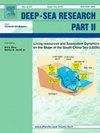Hard-bottom communities in the deep Fram Strait: patterns, processes, and looming questions
IF 3
3区 地球科学
Q2 OCEANOGRAPHY
Deep-sea Research Part Ii-topical Studies in Oceanography
Pub Date : 2025-07-05
DOI:10.1016/j.dsr2.2025.105506
引用次数: 0
Abstract
Hard-bottom habitats, including dropstones and rocky reefs, increase habitat heterogeneity and host unique communities in the Fram Strait. This manuscript synthesizes research on the composition and dynamics of hard-bottom communities over HAUSGARTEN's 25 years, combining known patterns with previously unpublished data. Our research reveals that hard-bottom communities have high biodiversity, including taxa that have not yet been identified or described. Research on reproduction in hard-bottom taxa has been limited. For the most common hard-bottom species, which include sponges, soft corals, and anemones, larvae tend to settle near their parents. Hydroids have much broader-range dispersal and serve as pioneer species in the deep Fram Strait. Results from two novel recruitment experiments (2015–2024, 2019–2024), combined with results from two previous studies, show the process of succession in hard-bottom communities. Initial recruitment of hydroids was followed by tube worms, sponges, and cnidarians, leading to a strong increase in rarefied species richness and differences in species composition over time. Tracking of the hard-bottom fauna on marked stones showed negligible growth and 0–23 % mortality over 5 years (2019–2024). In summary, our research indicates that hard-bottom taxa in the deep Fram Strait have short-range larval dispersal, low recruitment, and slow growth. These characteristics suggest that hard-bottom communities have limited resilience to anthropogenic disturbance.
海峡深处的硬底社区:模式、过程和隐现的问题
包括坠石和礁石在内的硬底栖息地增加了栖息地的异质性,并在弗拉姆海峡拥有独特的群落。这份手稿综合了HAUSGARTEN 25年来硬底层社区的组成和动态研究,结合了已知模式和以前未发表的数据。我们的研究表明,硬底群落具有很高的生物多样性,包括尚未被识别或描述的分类群。对硬底类群生殖的研究一直很有限。对于最常见的硬底物种,包括海绵、软珊瑚和海葵,幼虫倾向于在父母附近定居。水螅类的分布范围更广,是海峡深处的先锋物种。2015-2024年、2019-2024年两项新招募实验的结果,结合之前两项研究的结果,展示了硬底层社区的演替过程。随着时间的推移,管蠕虫、海绵和刺胞动物开始吸收水螅类,导致稀有物种丰富度的显著增加和物种组成的差异。对有标记的石头上的硬底动物群的跟踪显示,在5年(2019-2024年)期间,它们的增长可以忽略不计,死亡率为0 - 23%。综上所述,我们的研究表明,海峡深处的硬底类群具有幼虫传播距离短,招募率低,生长缓慢的特点。这些特征表明,硬底群落对人为干扰的恢复能力有限。
本文章由计算机程序翻译,如有差异,请以英文原文为准。
求助全文
约1分钟内获得全文
求助全文
来源期刊
CiteScore
6.40
自引率
16.70%
发文量
115
审稿时长
3 months
期刊介绍:
Deep-Sea Research Part II: Topical Studies in Oceanography publishes topical issues from the many international and interdisciplinary projects which are undertaken in oceanography. Besides these special issues from projects, the journal publishes collections of papers presented at conferences. The special issues regularly have electronic annexes of non-text material (numerical data, images, images, video, etc.) which are published with the special issues in ScienceDirect. Deep-Sea Research Part II was split off as a separate journal devoted to topical issues in 1993. Its companion journal Deep-Sea Research Part I: Oceanographic Research Papers, publishes the regular research papers in this area.

 求助内容:
求助内容: 应助结果提醒方式:
应助结果提醒方式:


